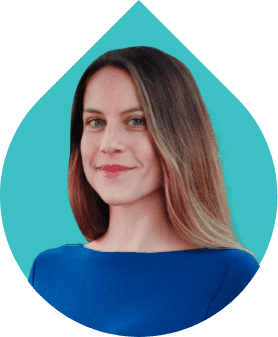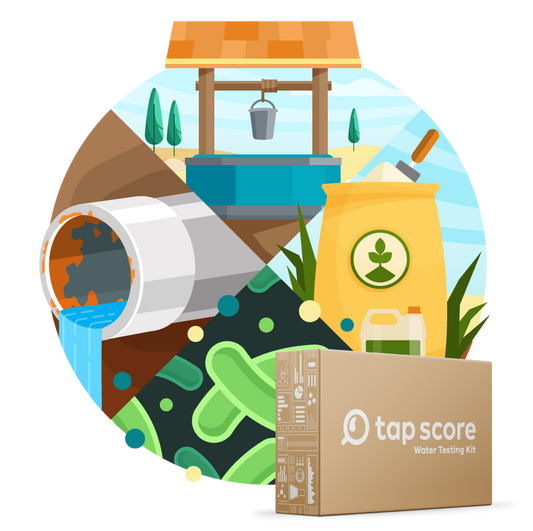
Where Does My Tap Water Come From?
Our blog is written by real experts— not AI. Each guide is carefully reviewed and updated based on the latest research. Plus, with no affiliate links, you can count on unbiased insights you can trust.
Water quality is shaped by its source.[1] Whether your drinking water originates from a groundwater well, a surface water source, or even a rain collection system, understanding the sources of tap water is key to making informed decisions about testing and treatment.
We’ll break down the main sources of tap water and what they mean for your water quality.
Table of Contents:
Key Takeaways:
- Surface water refers to any water source visible above ground, including lakes, rivers, streams, and ponds. The biggest source of surface water contamination in the U.S. is stormwater runoff.
- Groundwater refers to water from underground reservoirs known as aquifers. Groundwater is vulnerable to contamination from both natural sources and human activities.
- You can protect your drinking water no matter the source by installing a water filtration system in your home. But you need to know what specific contaminants are present—testing your water is the best way to find out.
Surface Water
Surface water refers to any water source visible above ground, including lakes, rivers, streams, and reservoirs. It accounts for about 71% of the nation’s freshwater supply and is the primary source for most public water systems.[2]
Sources of Surface Water Contamination
Because surface water is directly exposed to the environment, it is vulnerable to contamination from both natural processes and human activities. Common sources of contamination include:
- Wastewater Discharges: Untreated wastewater can introduce pathogens and other hazardous contaminants into water sources.
- Stormwater Runoff: Heavy rain can carry sediment, chemicals, pathogens and debris into water sources. Roadway pollutants like brake fluids, de-icing chemicals and petroleum compounds are often washed into stormwater runoff during a rain event.
- Algal Blooms: Certain algae growing in surface waters can produce taste and odor compounds or even harmful toxins when “blooms” occur.
- Agricultural and Landscaping Runoff: Herbicides, pesticides, insecticides, fungicides, and fertilizers can enter runoff from fields and landscaped areas and enter into water supplies.
- Chemical Spills: Industrial accidents can release hazardous substances into waterways.
- Mining and Oil Drilling: These activities can introduce volatile organic compounds, heavy metals, and hydrocarbons into the water sources.
As a result, water drawn from these sources must undergo treatment to ensure it meets health and safety standards.
The biggest source of surface water contamination in the U.S. is stormwater runoff.[3] When it rains or when people excessively water their lawns and gardens, water flows over paved surfaces and picks up chemicals, trash, and other contaminants from paved surfaces. These surfaces result in a decrease in the amount of water that soaks into the ground to recharge groundwater and also increases pollution in surface waters.
Groundwater
Groundwater forms as water from lakes, rivers, and precipitation seeps into the ground, replenishing underground reservoirs known as aquifers—porous rock formations that store large volumes of water. It accounts for 30.1% of the world’s freshwater supply, making groundwater a critical resource for drinking water.[4]

Both private well owners and public utilities rely on groundwater. While private wells typically draw exclusively from groundwater, many municipal water systems blend groundwater with other sources.
In the U.S., groundwater accounts for about 29% of the freshwater supply—about 15% of the population relies on private wells for their drinking water and 39% of source water for utilities comes from groundwater.[2,5]
Groundwater Contamination Risks
Like surface water, groundwater is vulnerable to contamination from both natural sources and human activities including:
- Asbestos: During construction activities, especially road work, grinding up certain types of rock can release asbestos fibers into the air, water and soil.
- Heavy Metals: Arsenic, chromium, and other metals are naturally occurring and can leach from surrounding rock.
- Bacteria: Contamination can result from poorly maintained septic systems or the presence of iron-reducing bacteria.
- Agricultural and Landscaping Chemicals: Pesticides, herbicides, insecticides, fungicides, and fertilizers can seep into groundwater supplies.
- Radionuclides: Naturally occurring radium, uranium, and radon contribute to high gross alpha radiation levels in some regions.
- Petroleum-related Compounds: Mining, drilling for oil and gas and other industrial activities can release a variety of hazardous compounds into water supplies, including volatile organic compounds and other hydrocarbons.
- Traffic-related Pollutants: Brake fluids, de-icing chemicals, and runoff from construction sites can impact groundwater quality.
Testing and Managing Private Wells
For private well owners, managing groundwater contamination is a personal responsibility. Unlike public water systems, private wells are not regulated, meaning regular testing—which is essential to ensure safe drinking water—is the responsibility of the well owner.
Groundwater conditions can change over time, making routine monitoring especially important. Many states provide recommended testing guidelines, which can be a helpful starting point.
Ultimate Guide to Well Ownership & Maintenance
At a minimum, the EPA advises annual testing for:[6]
- Total coliform bacteria
- Nitrates
- Total dissolved solids (TDS)
- pH levels
Tap Score offers specialized testing options for many groundwater contaminants, which can be added to any of our standard test kits.
How Do I Test My Well Water in a Lab?
Minor Sources: Seawater & Rainwater
While far less common than surface water and groundwater, rainwater and desalinated seawater serve as drinking water sources in certain regions and circumstances.
Seawater Desalination
Desalination is the process of removing salts and minerals from highly saline water to produce freshwater. While seawater is the most common source, brackish groundwater—water with high salinity levels—can also be desalinated.
For comparison:
- Freshwater contains less than 1,000 parts per million (PPM) of dissolved salts.
- Seawater contains over 35,000 PPM of salts.[7]
Desalination methods include distillation and reverse osmosis, both of which separate salt and other impurities to make water suitable for drinking.

Desalination is especially important in arid regions with limited freshwater resources, such as Australia or Israel, where large-scale facilities supply drinking water. There are some desalination facilities in states across the US as well, but they provide a very small fraction of the local drinking water. It is also used at a smaller scale by well owners dealing with high salinity or contamination in their groundwater.
Rainwater Collection Systems
Rainwater collection has been practiced for centuries, allowing people to capture and store rainfall for later use. Many homeowners install DIY rain barrels to collect water for irrigation. Others take it a step further, using rainwater as a primary water source—though this requires compliance with state regulations.
Rainwater Quality Concerns
While rainwater may seem pure, it can contain airborne pollutants such as particulate matter and organic contaminants that fall from the atmosphere.
Additionally, the materials used in collection and storage systems—such as rooftops, gutters, and barrels—can introduce metals, bacteria, or chemicals.
If rainwater is used for drinking, testing is essential to ensure proper treatment and filtration methods are in place.
Ultimate Guide to Rainwater Safety
How Can I Protect My Drinking Water Regardless of Source?
One of the most effective ways to protect your drinking water is by installing a water filtration system. However, selecting the right system depends on the specific contaminants present in your water. This is why testing your water first is essential.
Tap Score’s has a variety of kits designed for particular water sources and supplies. They always include free shipping both ways to a certified laboratory in its nationwide network.
Public Water Utility Water:
Private Well Water:
Rainwater:
Choosing and Maintaining a Filtration System
Some homes may only need a single, whole-house filter, while others require multiple filtration stages to address different contaminants.
Proper maintenance is critical—filters must be replaced on schedule to remain effective. Follow-up testing ensures the system is installed correctly and continues to function as intended.
Neglecting filter maintenance can have the opposite effect—overloaded or expired filters may begin leaching contaminants back into the water instead of removing them. Many systems are installed and forgotten in basements or utility rooms, leading to reduced effectiveness over time.
How Do You Pick the Best Water Filter for Your Home?
Protecting Water at the Source
Freshwater is a limited resource, and human activities significantly impact water quality. Beyond individual filtration, communities and homeowners can take steps to protect source water, including:
- Maintaining septic systems to prevent leaks and bacterial contamination.
- Plugging up and decommissioning old wells properly.
- Reducing fertilizer and pesticide use to minimize runoff into surface and groundwater.
- Supporting local water protection efforts that focus on preserving clean drinking water supplies.
By taking both preventative measures and proper filtration steps, you can help ensure that your drinking water remains as clean and safe as possible.
Sources & References
▾- Drinking Water Sources: An Overview
- Groundwater Use in the United States of America
- How Stormwater Affects Your Rivers
- Groundwater Storage and the Water Cycle | U.S. Geological Survey
- Domestic (Private) Supply Wells | U.S. Geological Survey
- Protect Your Home's Water | US EPA
- Desalination | U.S. Geological Survey








